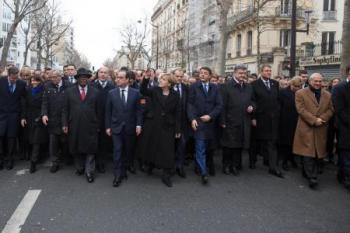The Escalating "War on Terror": Is there a Role for Conflict Resolution?
The Escalating "War on Terror": Is there a Role for Conflict Resolution?
 Clint Eastwood’s Oscar-nominated film American Sniper (2014), the most profitable war movie ever made in the United States, encapsulates the problem of thinking about America’s “war on terror.” Most of the film’s crucial scenes are shown from the point of view of Chris Kyle, the heroic Navy SEAL sniper. From the very start, the visual and moral field narrows down to what Kyle sees through the scope of his high-powered rifle: an Iraqi mother hiding an anti-tank grenade under her chador and giving it to her child to use against U.S. troops; an insurgent teenager preparing to fire a rocket-propelled grenade; a sadistic Iraqi torturer; a fiendishly accurate enemy sniper – all guilty of trying to kill Americans, and all meriting death at Kyle’s hands. As Chris Hedges points out in a brilliant, acerbic takedown of the movie, there are virtually no innocent “natives” in the film:
Clint Eastwood’s Oscar-nominated film American Sniper (2014), the most profitable war movie ever made in the United States, encapsulates the problem of thinking about America’s “war on terror.” Most of the film’s crucial scenes are shown from the point of view of Chris Kyle, the heroic Navy SEAL sniper. From the very start, the visual and moral field narrows down to what Kyle sees through the scope of his high-powered rifle: an Iraqi mother hiding an anti-tank grenade under her chador and giving it to her child to use against U.S. troops; an insurgent teenager preparing to fire a rocket-propelled grenade; a sadistic Iraqi torturer; a fiendishly accurate enemy sniper – all guilty of trying to kill Americans, and all meriting death at Kyle’s hands. As Chris Hedges points out in a brilliant, acerbic takedown of the movie, there are virtually no innocent “natives” in the film:
"Mothers and sisters in Iraq don’t love their sons or their brothers. Iraqi women breed to make little suicide bombers. Children are miniature Osama bin Ladens. Not one of the Muslim evildoers can be trusted—man, woman or child. They are beasts. They are shown in the film identifying U.S. positions to insurgents on their cellphones, hiding weapons under trapdoors in their floors, planting improvised explosive devices in roads or strapping explosives onto themselves in order to be suicide bombers. They are devoid of human qualities." (“Killing Ragheads for Jesus,” truthdig, January 25, 2015).
The name of this cinematic and political game is extreme focus: a limitation of vision, at first willful, later apparently “natural,” that occludes or eliminates background, context, motives, and causation. Extreme focus ensures that the sniper kills no one by accident, nor do U.S. air strikes or ground attacks cause any observable collateral damage. By narrowing the field, the focus prevents us from developing any idea of why the insurgents fight. They fight because they are aggressive – a sinister tautology which immediately produces an American motive: Kyle and his comrades are there to defend each other, and the Homeland, against Muslim aggressors.
One might call this view of the enemy a focused blur. The sniper and his son see the results of al Qaeda’s truck bomb attacks on U.S. embassies in East Africa on television. Then he and his wife witness the 9/11 attacks on the World Trade Building and the Pentagon. Finally, impelled by a vision of himself as a violent protector (“Regardless of what your mama told you, violence does solve problems”), he becomes one of the invaders of Iraq, hunting down insurgents whom he calls “savages” and identifies with previous prevous Muslim enemies.
The invasion’s role in generating insurgency is, of course, entirely outside the scope of his vision. Meanwhile, the “savages” live up to their billing when hundreds of them surround Kyle and his buddies in Fallujah in a clear replay of the climactic Cowboys vs. Indians battle that ends so many Hollywood Westerns. Here, the exclusionary focus serves the additional purpose of turning the forces whose mechanized assaults killed tens of thousands of Iraqis and led to the deaths of hundreds of thousands more into an outnumbered, outgunned handful of heroes.
“American Sniper” deserves a far longer discussion. Since many people believe that its vision is noble and true, even that its depiction of Kyle’s PTSD and family difficulties makes it an “anti-war” movie, it deserves the sort of public discussion that S-CAR helped organize in the case of Mel Gibson’s equally divisive film, “The Passion of the Christ” (2004). But the issue I want to emphasize here is how extreme focus, eliminating both breadth and depth, historical context and psychological motivation, afflicts our general approach to the “War on Terror” and effectively rules out conflict resolution.
In a previous book (Rubenstein, 2010), I argued that such a narrowing of vision often occurs as public attention is drawn increasingly to the depredations of hostile foreign forces. People generally begin as skeptical of hawkish claims and demands. But this skepticism fades when enemy atrocities, sometimes involving American victims, seize center stage. We are revolted and affrighted by the adversary’s methods and ideology. As violent, sinister forces make territorial and propaganda gains, a growing sense of vulnerability inclines us to think in terms of self-defense. Soon, all we can see is what appears in the sniper’s scope: in this case, Muslim extremists attacking cities, beheading hostages, slaughtering captured soldiers, destroying priceless antiquities, and threatening to annihilate civilians they brand “apostates.”
What motives can they possibly have? In particular, what can explain the propensity of Islamic State leaders to produce and circulate slick videos of their fighters committing such atrocities? A current answer commanding wide attention explains that, as passionate fundamentalists, they believe in the justice and current applicability of all the customs and punishments described in the Koran, from slavery and concubinage to crucifixion and the execution of prisoners. Moreover, like the Aum Shinryko sectarians who released poison gas in a Tokyo subway twenty years ago, they are fanatical believers in a coming apocalypse: an end-of-days battle with Christian forces (“Rome”) that will inaugurate the messianic kingdom and return the Islamic empire to its former glory (Wood, 2015. For competing views, see Jenkins, 2015, and Tharoor, 2015). Other commentators, stressing the Islamic State’s capture of territory and campaign to create a united caliphate, have compared its leader, Abu Bakr al-Baghdadi, to the megalomaniac German conqueror, Adolf Hitler. According to them, what attracts recruits to the extremist camp is conquest, which produces jobs, loot, adventure, comradeship, sexually exploitable women, and glory. Videos dramatizing the conquerors’ ruthlessness thus offer power and pride to potential allies while spreading fear among potential enemies.
These views, which imply the necessity to fight to the death against ISIS and its sympathizers, are not so much wrong as blindingly partial. They neither ask nor answer questions like: How did a handful of violent ideologues become the rulers of a state that “now controls territory the size of Belgium, governs millions of people, draws on billions of dollars in revenue and commands tens of thousands of foot soldiers” (McCaul, 2015)? Why have so many people, including young Muslims from Western nations and Sunnis who do not share the ISIS theology, attempted to join forces with them or to aid them? Why is their influence spreading so rapidly outside Iraq and Syria? Responding to such inquiries requires that one pay attention to the history of the region, including the roots of Sunni-Shia conflict, the legacies of colonial rule, the role of capitalist institutions in generating mass joblessness and inequality, and the story of how Western interventions abetted the rise of Islamist extremism. Perhaps more important, it requires broadening one’s focus to include the basic needs of Arab and other Muslim peoples (not just their leaders) which, unsatisfied, incline masses of alienated people to support extremist solutions.
What are these needs? Only those suffering deprivation can tell us, but they seem to include an end to gross political, judicial, and economic corruption – a demand that has fueled violent puritanical movements since the Protestant Reformation – as well as needs for decent jobs; opportunities for morally fulfilling, socially useful work; satisfying personal relationships; secure, positive cultural identities; and the right to make collective decisions and to decide one's own fate free of foreign domination. (Surely, the demand for a revived “caliphate,” which many Westerners view as unspeakably weird, reflects a widespread distaste for the political divisions imposed upon Arab peoples by the Sykes-Picot agreement of 1916 and other colonial ‘divide and conquer’ schemes.) If, in fact, people are joining extremist organizations in order to satisfy such needs, the question that then demands an answer is precisely that of conflict resolution. How can the parties caught up in brutal conflict be brought together to determine for themselves what imperative needs demand satisfaction and what institutional changes are required to do the job?
This question also indicates what’s missing in the Hitler/al-Baghdadi analogy. Having captured Europe's leading industrial state (with the aid of its leading industrialists), and joined forces with Asia's leading industrial state, Adolf Hitler and his Axis allies could be dealt with in no way other than all out war. Before the 1930s, however, when Germany was saddled with war guilt, impoverished, and humiliated by myopic Allied leaders, policies devoted to conflict resolution rather than punishment might well have helped satisfy the urgent needs that, left to fester, led directly to the rise of the Nazis.
The situation in the Middle East at present seems much closer to that of the twenties than the thirties. The problem is how to prevent ISIS from winning the loyalty of the Muslim masses and committing further atrocities against non-Sunnis and Sunnis they consider impious or apostates. The solution, I believe, is not to fight the apocalyptic war the extremists seem to be hoping for, but, while helping to defend communities threatened by extinction, to make it possible for representatives of warring peoples who are willing to talk with each other do so. Attempts to wipe out groups like ISIS will produce only pyrrhic victories, since unsatisfied basic needs will continue to generate violent extremism. Surely, it's time to see what can be done by the parties themselves, assisted by trusted, independent facilitators, to resolve a network of escalating conflicts.
Sources
Jack Jenkins (2015). “What the Atlantic Gets Dangerously Wrong about ISIS and Islam,” Think Progress (February 18) http://thinkprogress.org/world/2015/02/18/3624121/atlantic-gets-dangerously-wrong-isis-islam/
Michael T. McCaul (2015), quoted in Andy Heller, “Islamic State has grown to size of Belgium,” Matzav (February 12). http://matzav.com/islamic-state-has-grown-to-size-of-belgium
Richard E. Rubenstein (2010). Reasons to Kill: Why Americans Choose War. Bloomsbury Press
Ishan Tharoor (2015). “The Misguided Debate About How Islamic the Islamic State Is,” Washington Post (February 20) http://www.washingtonpost.com/blogs/worldviews/wp/2015/02/20/the-misguided-debate-about-how-islamic-the-islamic-state-is/
Graeme Wood (2015). “What ISIS Really Wants,” The Atlantic (March) http://www.theatlantic.com/features/archive/2015/02/what-isis-really-wants/384980.
### Photo from 1/11/2015 - 60 world leaders gathered in Paris to participate in a unity march to show solidarity with France and honor attack victims. Flickr user Matthieu de Martignac/OECD.




